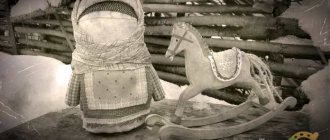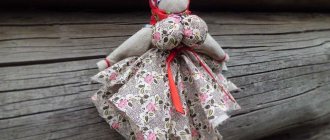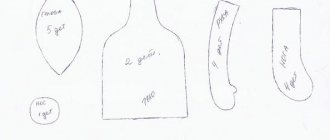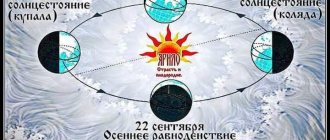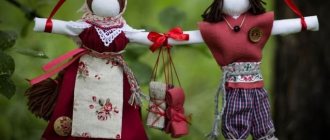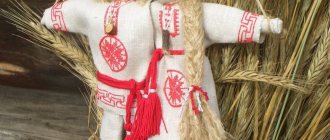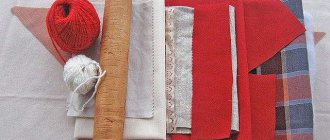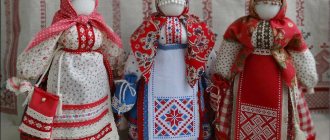Easter doll
The Easter doll is an Orthodox woman dressed in a beautiful outfit. She blesses Easter food in church, holding a bundle of gifts in her hands. Her clothes are in red tones. To make a doll, you will need a square of red fabric, thick fabric, a scarf, an overskirt, an underskirt, an apron, a square of fabric, braid, and ribbons.
Fold the thick fabric in half, and then twist the strip into a tube. Then place a piece of cotton wool on top.
cover the tube with a square of red cloth. Fold the corners of the fabric inside, and then fold the sides in half. Make palms and tie your hands with thread. Then lift the front of the red fabric and place a piece of padding polyester to the neck.
Wrap the waist and tie the threads. Tie on a skirt made of thick fabric. Sew ribbons and lace on top. Then assemble the top of the skirt. Next, assemble the apron onto a thread. On the face you need to form a cross from braid. Read more about how to make a doll below. This is quite a long process.
Easter dolls. History, traditions
Natalya Plakhteeva
Easter dolls. History, traditions
There are many spring folk dolls, because spring is a very important period in the life of a peasant. In addition, it is in the spring that Orthodox people celebrate one of the main holidays, Bright Sunday of Christ - Easter . Celebrating Easter is a centuries-old folk tradition .
On Easter it was customary to congratulate each other on the holiday. Easter treats and gifts were given to relatives and friends : special Easter souvenirs - painted things and objects with Easter symbols , as well as special Easter dolls .
folk dolls associated with the celebration of Easter : Verbnitsa, Easter , Easter Dove Easter Bunny toys
, bunny
“For
Easter egg ” .
There is no specific date for these dolls, because Palm Sunday and Easter are moving holidays and according to the Orthodox calendar they occur from the very last days of March to the first days of May.
Easter dolls are made in bright red colors, because red has always symbolized life, and Easter Sunday is a great holiday of life and rebirth.
Easter dolls in my collection of rag dolls . They are all different, in bright festive outfits.
But this year I wanted to make them all in the same style, or rather, so that each of them would have the same fabric in their outfit - scarlet and silver brocade.
For example, this Easter Bunny toy
made entirely from a piece of brocade
And this bunny “For Easter egg ”
knitted from snow-white thread, and I made the skirt from brocade
The most beautiful holiday doll is called the Easter doll . She represents an Orthodox woman in elegant clothes.
the Easter doll itself does not differ from the general technology of making Russian rag dolls, but the face and hands of the doll are always made of red fabric. In her hands the doll holds a bundle with what she is bringing to the temple for consecration. Sometimes a candle was added to the doll and tied to its hand. such a doll was an unusually beautiful and expensive gift for the Holy Holiday.
My Easter doll put on a brocade overskirt and tied a brocade scarf on her head.
The Easter Dove doll is very beautiful . In the old days it was hung on a window or in a doorway. And with any breath of wind, the doll spins, opening her elegant fluffy skirts, and it seems as if she is flying.
Easter Dove doll has also changed . A bright cross ribbon appeared on her chest and a belt made of scarlet and silver brocade
And here is the doll “Verbnitsa”
I have a new one.
The doll that I have in my collection has a completely different outfit. And in order not to remake that doll , I decided to make myself a new one in a bright brocade dress. This is how it turned out for me
Now I have a new set of Easter dolls . Such dolls were made to decorate the house a week before Easter for Palm Sunday. They were placed on the window to show that in this house people were waiting for the onset of Easter Sunday . Later the dolls were placed on the table near the Easter gifts.
Easter doll: history and meaning
Easter is one of the brightest and most joyful holidays. In terms of fun, it is second only to Maslenitsa. But if Maslenitsa was celebrated by almost the entire village, then Easter is a more family holiday.
Traditionally, holidays were spent with close people. They didn’t forget about distant relatives. People went to visit each other, exchanging special phrases instead of the usual greetings.
The person who came to visit said: “Christ is risen,” and in response he heard: “Truly he is risen.” This custom is still widespread in Slavic countries today, but other peoples do not have such a greeting.
Almost everyone knows about Easter attributes such as Easter cake and krashenki. The Easter doll is not known to many people, but it still remains an important Easter attribute. The colorful, elegant motanka was made on the eve of Palm Sunday. The Easter doll was an important Easter attribute among the Slavs.
View this post on Instagram
Posted by Rag Dolls with Soul (@kukla.marfa) Apr 27, 2019 at 1:02 PDT
At first, the doll was placed on the window to show that the family was waiting for Easter Sunday. When this day came, she was transferred to the red corner, where the amulet stood until the next spring.
There are several versions about what such a reel symbolized. One of the options is waiting for spring, the joy of the rebirth of Christ. There is also an opinion that she personifies a woman going to church to bless the Easter cake and dyes.
Folk Easter dolls
Soon, very soon, the bright holiday of Easter! We are all getting ready, choosing gifts. Now, in times of globalization of everything, I especially want to find a gift that is unique, colorful and, of course, fully consistent with the spirit of the holiday. Why not pay attention to folk dolls?
After all, unfortunately, we know very, very little about them. Meanwhile, in the Russian tradition, there is not one, but several ritual dolls that were made specifically for the Easter holiday! We'll talk about them today.
Long before Christianity, the day when we celebrate Easter was called Svyatosar - Day or Velik - Day. And for this day a special doll was made - the Holy Mother. It symbolizes the birth of a new dawn, the emergence of a new beautiful world full of light! The doll must have an egg in its hands - a symbol of a new emerging life.
On Palm Sunday, which is celebrated a week before Easter, a special doll is created - Verbnitsa. It is based on a willow twig, and the doll itself is traditionally made in green tones. In general, willow was given special attention in Rus'.
This tree has always been associated with powerful vitality, the energy of awakening and restoration. Willow branches can be stored in the house for a whole year. And if the willow takes root, this is a very good sign, promising well-being and health to everyone in this house.
After the adoption of Christianity in Rus', the willow took an even more important place - it replaced the palm branches with which the inhabitants of Judea greeted Christ in our culture, and became one of the main symbols of the Easter holiday. Blessed willow branches are even kept in the red corner or behind the icons, because it is believed that they protect the house and people from various troubles and misfortunes all year round.
In the hands of the Verbnitsy doll, three willow branches are traditionally placed. The doll carries them to be blessed in the church. Sometimes in the hands of such a doll there may be both an Easter cake and an egg, intended for the same purpose. Such a doll takes pride of place in the house, placed next to the Easter doll.
Making an Easter doll was once equal in importance to painting Easter eggs. This is a very important and beautiful doll! It symbolizes the holiday itself, Bright Sunday.
Traditionally, the doll's face and hands are made of red fabric. Either it is literally a red fabric, or a very elegant, spectacular fabric. After all, “red” means “beautiful.” This doll is also taken to the church for consecration, and then placed next to Verbnitsa in the most honorable and prominent place. The Easter doll is the main doll of the holiday!
There is another special doll - Easter Dove. Compared to other holiday dolls, she looks strict and restrained. A prerequisite for this doll is that it is made in red. And no additional decorations! (as the famous researcher of folk dolls Irina Agayeva writes in her works).
This doll is a symbol of universal love and a symbol of good news. The peculiarity of such a doll is the “hairstyle”: part of the head is formed into a special knot and secured with threads. It is by this knot that the doll is suspended (not placed!), it seems to be flying!
View this post on Instagram
Publication from Handmade by Marie (@marina_gibovsky) March 26, 2021 at 4:23 PDT
But not all Easter dolls follow such strict rules. In folk tradition, there are also souvenir dolls intended specifically as gifts, created only to bring joy to people. For example, a doll for an Easter egg. She is both a beautiful doll and an original “packaging” for an Easter egg. Inside the doll there is a special pocket where the egg is placed.
Children will love this surprise! And he will not leave adults indifferent either!) And after the holiday, the doll can be used as a souvenir or game!
Of course, we cannot ignore folk dolls - angels. Each master produces them with their own unique appearance and character. Small and big, sad and joyful... the main thing is that they bring us love and kindness! Namely, this is the best gift for the holiday!
Among the Easter dolls there are many designer ones. No wonder. Folk dolls cannot be attributed only to history! They continue to live and develop here and now. And the Easter theme inspires craftsmen to create new dolls - images. For example, the image of Mary Magdalene with a red egg in her hands.
Of course, we did not mention all the folk Easter dolls. After all, the world of folk dolls is so large and diverse! And getting to know them is incredibly interesting!
Folk Easter dolls
Soon, very soon, the bright holiday of Easter!
We are all getting ready, choosing gifts. Now, in times of globalization of everything, I especially want to find a gift that is unique, colorful and, of course, fully consistent with the spirit of the holiday. Why not pay attention to folk dolls? After all, unfortunately, we know very, very little about them. Meanwhile, in the Russian tradition, there is not one, but several ritual dolls that were made specifically for the Easter holiday! We'll talk about them today.
Long before Christianity, the day when we celebrate Easter was called Svyatosar - Day or Velik - Day. And for this day a special doll was made - the Holy Mother. It symbolizes the birth of a new dawn, the emergence of a new beautiful world full of light! The doll must have an egg in its hands - a symbol of a new emerging life.
On Palm Sunday, which is celebrated a week before Easter, a special doll is created - Verbnitsa. It is based on a willow twig, and the doll itself is traditionally made in green tones. In general, willow was given special attention in Rus'. This tree has always been associated with powerful vitality, the energy of awakening and restoration. Willow branches can be stored in the house for a whole year. And if the willow takes root, this is a very good sign, promising well-being and health to everyone in this house.
After the adoption of Christianity in Rus', the willow took an even more important place - it replaced the palm branches with which the inhabitants of Judea greeted Christ in our culture, and became one of the main symbols of the Easter holiday. Blessed willow branches are even kept in the red corner or behind the icons, because it is believed that they protect the house and people from various troubles and misfortunes all year round.
In the hands of the Verbnitsy doll, three willow branches are traditionally placed. The doll carries them to be blessed in the church. Sometimes in the hands of such a doll there may be both an Easter cake and an egg, intended for the same purpose. Such a doll takes pride of place in the house, placed next to the Easter doll.
Making an Easter doll was once equal in importance to painting Easter eggs. This is a very important and beautiful doll! It symbolizes the holiday itself, Bright Sunday.
Traditionally, the doll's face and hands are made of red fabric. Either it is literally a red fabric, or a very elegant, spectacular fabric. After all, “red” means “beautiful.” This doll is also taken to the church for consecration, and then placed next to Verbnitsa in the most honorable and prominent place. The Easter doll is the main doll of the holiday!
There is another special doll - Easter Dove. Compared to other holiday dolls, she looks strict and restrained. A prerequisite for this doll is that it is made in red. And no additional decorations! (as the famous researcher of folk dolls Irina Agayeva writes in her works). This doll is a symbol of universal love and a symbol of good news. The peculiarity of such a doll is the “hairstyle”: part of the head is formed into a special knot and secured with threads. It is by this knot that the doll is suspended (not placed!), it seems to be flying!
But not all Easter dolls follow such strict rules. In folk tradition, there are also souvenir dolls intended specifically as gifts, created only to bring joy to people. For example, a doll for an Easter egg. She is both a beautiful doll and an original “packaging” for an Easter egg. Inside the doll there is a special pocket where the egg is placed.
Children will love this surprise! And he will not leave adults indifferent either!) And after the holiday, the doll can be used as a souvenir or game!
Of course, we cannot ignore folk dolls - angels. Each master produces them with their own unique appearance and character. Small and big, sad and joyful... the main thing is that they bring us love and kindness! Namely, this is the best gift for the holiday!
Among the Easter dolls there are many designer ones. No wonder. Folk dolls cannot be attributed only to history! They continue to live and develop here and now. And the Easter theme inspires craftsmen to create new dolls - images. For example, the image of Mary Magdalene with a red egg in her hands.
Of course, we did not mention all the folk Easter dolls. After all, the world of folk dolls is so large and diverse! And getting to know them is incredibly interesting!
I sincerely wish that the upcoming Bright Holiday brings a lot of joy, happiness and love!)))
Easter doll (Easter)
Easter is the most important holiday of the Orthodox church year. Easter celebrates the resurrection of Jesus Christ; this holiday personifies the victory of good. Celebrating Easter is a centuries-old folk tradition, since in Rus', even before Christianization, it was a holiday of the awakening of nature and the beginning of spring.
It is customary to prepare for Easter in advance; on the eve of Easter, Orthodox Christians gather for prayer in churches and the blessing of Easter food. These are special dishes that are prepared only once a year - Easter colored eggs, Easter cottage cheese and Easter cake. A very interesting Easter tradition is colored eggs.
In ancient times, the egg was an object of worship for people. In ancient times, many peoples believed that it symbolizes the mystery of life, an endless chain of births and deaths. Nowadays eggs are painted in all the colors of the rainbow, but the most common color is red. Our ancestors firmly believed in the magical powers of the color red - a symbol of life.
View this post on Instagram
Posted by Rag Dolls with Soul (@kukla.marfa) Apr 16, 2019 at 7:32 am PDT
And then came the great holiday - the bright Resurrection of Christ. After visiting the church, a solemn festive feast was held at home. This was followed by entertainment, all kinds of games, mainly with Easter eggs, street celebrations and swing rides.
There was also a tradition of visiting the cemetery to remember the dead. Some Easter treats and colored eggs were left on the graves. On Easter it was customary to “Christify”, congratulating each other on the holiday.
Close people were given Easter treats and gifts: special Easter souvenirs - painted things and objects with Easter symbols and special Easter dolls: Verbnitsa, Easter and Easter Dove.
Such dolls were made to decorate the house a week before Easter for Palm Sunday. They were placed on the window to show that they were waiting for the onset of Easter Sunday. Later, the dolls were placed on the table near the Easter gifts.
The most beautiful holiday doll is called the Easter doll. She represents an Orthodox woman in elegant clothes who goes to consecrate traditional Easter food in church, holding a bundle of gifts in her hands. An Easter doll is made in red colors.
The color red has always symbolized life, and Easter Sunday is a great holiday of life and rebirth. The making of the Easter doll itself does not differ from the general technology of making Russian rag dolls, but the face and hands of the doll are always made of red fabric.
A yellow or gold cross is often woven onto the face - a symbol of Christ. In her hands the doll holds a bundle with what she is bringing to the temple for consecration. Sometimes a candle was added to the doll and tied to its hand.
Such a talisman doll was an unusually beautiful and expensive gift for this bright holiday.
- square of red fabric 28x28 cm;
- dense fabric intended for twisting, size 45x37 cm;
- scarf 28x28 cm;
- overskirt 40x17 cm;
- petticoat 25x30 cm;
- apron 10x15 cm;
- square of fabric for a knot 12x12 cm;
- braid, ribbons, threads, cotton wool or padding polyester;
The doll's height is 20 cm.
- Fold a rectangle of thick fabric in half.
- We twist the strip into a tube and tie it approximately in the middle.
- The end of the tube along the fold of the fabric will be the bottom of the doll’s body, and on top we place a lump of padding polyester or cotton wool.
- Cover the top of the tube with padding polyester with a square of red fabric. We form the head and tie it with thread.
- Let's make hands. We bend the corners of the fabric inward, then fold the sides of the fabric over each other and fold it in half.
- We make palms. We tie the handles with thread, stepping back 1.5 cm from the edge.
- We lift the front end of the red fabric and place a piece of padding polyester to the doll’s neck to form the chest.
- We wrap the doll's waist and tie the threads.
- For greater stability, we tie a petticoat made of thick fabric to the doll. It can also be sewn on.
- We add braid, ribbons or lace to the upper skirt and sew the sides.
- We gather the top of the skirt with a double thread, bend the top section inward, put it on the doll, tighten it and tie it.
- We collect the apron on a thread and tie it at the waist.
- On the doll's face we form a cross from braid, narrow ribbon or thread. We wrap the braid over the head and wrap it tightly and tie it to the neck. Cut off the end of the braid.
- Take another 20 cm piece of braid. Wrap it across the face and tie the ends at the back to the first piece of braid, trim off the excess ends.
- We tie or sew a braid to the top of the head, this will be an imitation of a warrior.
- We tie the belt. We tie the doll's head with a beautiful scarf.
- Place a lump of padding polyester or cotton wool in the center of the square patch.
- We tie a knot for the doll with a thread.
- We tie a knot to one hand of the doll with a ribbon, and a small candle to the other. You can put beautiful beads on the doll's neck.
The elegant Easter doll is ready for the holiday!
View this post on Instagram
Posted by Galina (@galina.8416) May 22, 2021 at 11:44 PDT
Bereginya doll “Verbnitsa”
Craftswomen began making Easter dolls a week before Easter, and for Palm Sunday, they decorated the windows in the house. The willow doll displayed in the window symbolized that the family was ready to celebrate Easter Sunday. Today, many craftswomen are keen on making textile amulets dolls. During work, they do not touch the product with sharp or cutting tools. The whole process consists of twisting the patchwork elements with thread. Willow is vitality and energy. It is inserted into the hands of the doll and consecrated in the temple. The production of Verbnitsa and Easter eggs follows the same technology. The color scheme is influenced by the ideology and theme of the holiday. They can be distinguished by color, as well as by the attributes that are attached to their hands. For Easter I make a doll in red colors, the face can be red or white. When linked to Palm Sunday, yellow or green colors predominate.
The Verbnitsa doll can be made with different hand positions:
- Join your hands and insert palm branches into your palms.
- Raise or bend one hand and insert a willow twig, and lower the other.
- Lower both hands. Attach a willow twig to one of them. In the second hand there is a bundle in which you can put salt and grain or grain and herbs: calendula, chamomile.
- Place your arms at your sides and attach pussy willow branches to the belt at your waist.
- Also attach to the outstretched hands: in one willow, and in the second a church candle.
According to ancient customs, motanka was made only for one day, and was given as a gift on Palm Sunday. Together with her they sent thoughts so that the earth would be fertile and new life would be reborn. It was stored until the next holiday, then dismantled into parts and burned.
Let's consider a master class on making Verbnitsa reel.
Material:
- a piece of thick fabric for twisting - 40*80 cm;
- white fabric - 24*24 cm;
- colored fabric - 50*17 cm;
- rectangular flap for an apron - 12*6 cm;
- yellow triangle - 15*15 (roll into a scarf);
- green triangle - 20*20 (roll into a scarf);
- belt made of threads;
- green ribbon;
- padding polyester or cotton wool;
- several branches of willow.
Easter amulets dolls
The Easter doll-motanka, in whose hands there is a willow twig or pysanka, is considered the personification of the Virgin Mary. Such dolls do not have faces, so through such a talisman no one can harm a person.
You should not think that making such a talisman requires any specific knowledge and skills. You can find many master classes where the entire technology for making Easter reels is clearly shown.
Most often, such dolls are created from pieces of old clothes, which are imbued with the energy of a person and family. Things left over from grandparents will be especially valuable, but such clothes must be “happy.” Items that were worn during illness or difficult life situations cannot be used.
The craftswoman herself has the right to decide what exactly such an Easter doll will help its owner with. To do this, you should form certain images and wishes in your head, which should be spoken out when creating the motanka head. There should be only one knot on the doll, which is tied at the end of the work in the navel area. At the moment of tightening the knot, you should make a wish.
Traditional pysanka
Pysanka is an egg decorated with special symbols. They are applied to the shell using wax or special dyes. In the photo you can often see Easter eggs that look like real works of art. Depending on the pattern, pysanka can bring good luck, prosperity, wealth and health to the home. Such amulets can be made both for yourself and as a gift to family and friends.
The most common patterns on pysanka amulets are:
- Sun. Heavenly fire represents justice, new knowledge, and overcoming obstacles.
- Cross. One of the main sacred signs, depicting it on an egg, you wish the recipient to further move along the path of his development.
- Svarga. It is believed that this sign protects against dark forces and attracts goodness and prosperity.
- Star. Easter eggs with the image of a star are usually given to unmarried girls, since such a talisman is intended to help in finding a betrothed.
- Triangle. This symbol is often used both as a basic element and as a basis for constructing a drawing.
Close the house from all evil
Returning from church on Easter Sunday, you should go up to a young birch tree and pick three thin branches (after turning kindly to the tree, asking for help and forgiveness for the trouble).
At home, sprinkle these twigs with stored holy water and speak for protection from illness, evil people and all negativity. Next, attach a branch above three doors (entrance, kitchen and leading to the bedroom).
By starting to prepare ahead of time, you can make a personal Easter amulet.
- From Tuesday to Thursday, sew a small bag from cotton or linen fabric.
- On Thursday, bless the willow.
- Directly on Sunday, after sharing Christ with someone close to you, leave some colored eggshells.
- In the evening, write a prayer and wishes addressed to the Higher Powers on a piece of paper.
- Place in a bag, adding shells and three willow buds.
- Tie it with red woolen thread and carry it with you all year round.
Since ancient times, Easter dolls and amulets have been especially revered in Rus'. They were pre-twisted from bright fabric (preferably in golden and red shades), and then given to the closest people with wishes of happiness, good luck and prosperity.
The meaning of verbina
The main attribute of the willow doll is willow branches placed in the hands or tied to the belt.
Verbnitsa is made as a symbol of the spring holiday. Acts as a home talisman protecting family well-being. Unites folk and Christian traditions in the celebration of Palm Sunday. The doll, along with Easter eggs and willow branches, belongs to the attributes of Palm Sunday.
Amulet dolls ↑
Easter amulets dolls are another symbol of the Great Holiday. A week before Easter, for Palm Sunday, they make a Verbnitsa doll. Making such a doll is equivalent to the ritual of painting Easter eggs. Verbnitsa, according to tradition, is given to relatives on Easter Sunday.
The amulet is a female figurine with willow branches in her hands. To make the motanka, colorful, “spring” pieces of fabric were chosen, and a cross was embroidered on its face. For our ancestors, the willow was a symbol of vitality, since it blossomed early in the spring and absorbed the energy of the first sun. It was believed that willow branches have magical properties - they protect people from evil and disease. They were placed in the hut before the Trinity holiday - together with the Verbnitsa doll, they occupied a place of honor in the house (if one of the family members fell ill, he was lightly whipped with a willow branch and a healing spell was cast).
The Verbnitsa doll occupied a place of honor in the house
Another holiday amulet is the Easter doll. It symbolizes a woman going to church for Easter service. The doll holds a small bundle in her hands. The amulet is traditionally made from red scraps of fabric representing the Blood of Christ. A cross is depicted on the doll's face.
The Easter amulet is made in different versions. One of them is an Easter egg doll. It is wound from bright shreds of red shades. The secret of the amulet is the paint hidden inside it. This surprise doll is a wonderful holiday gift.
The Easter Dove amulet doll is a symbol of the good news and resurrection.
It is a female figurine made of red rags. If the doll is hung by a loop at the back of its head, it floats in the air and resembles a dove. The amulet is designed to protect the house from evil and preserve the good memory of the departed until next Easter.
Features of making folk dolls
Motanka is made from bright scraps of fabric in green, blue and yellow shades. The addition of bright red color is welcome, embodying the passion characteristic of spring. The fabric can be chosen with a floral pattern. In addition to the willow, the amulet can be supplemented with a bird, which also personifies spring, or with a knot.
You can put in the bag:
- grain as a symbol of fertility,
- salt to enhance the protective properties of the pupa;
- herbs representing health.
The green color of the camel's clothing symbolizes life, the awakening of nature, the blossoming of vital energy.
The technique for making motanka is similar to the Easter one. They can be performed according to the same scheme. The only difference is the color of the clothes. For an Easter doll, you should choose clothes in red shades.
As decoration, you can use colored natural threads, ribbon, embroidery, beaded beads, knitted or sewn flowers to decorate clothes.
To make a protective doll, you can use fabric from used clothes. When making an interior toy using the folk doll technique, it is important to take new fabric so as not to spoil the overall appearance.
We create a ritual folk doll “Verbnitsa”
- Difficulty: below average
- Working time: 4 hours
- Materials: double thread, cotton, linen, flax fiber, cotton lace, irises, willow, self-hardening clay, pva glue, moment glue, hot glue
Materials and tools.
For the base of the doll:
- wooden stand with pin;
- double-thread fabric for twisting;
- white linen (cotton) fabric, cotton wool:
- durable cotton threads.
Costume materials:
- plain cotton in green shades;
- fabric with a pattern of green shades;
- gray jacquard linen;
- cotton lace;
- flax fiber;
- iris threads in green shades;
- scattered beads;
- willow branches.
Tools.
- glue “Moment-crystal” PVA glue;
- glue gun;
- tailor's scissors;
- iron;
- watercolor, acrylic varnish;
- self-hardening clay.
Notes.
- To make folk dolls, I use only natural materials;
- To create a costume, it is better not to cut fabric with scissors, but to tear it by hand. Scissors are only needed to make a small cut. This method allows you to carefully process the fabric and create a small fringe.
- All details of the costume and folds of fabric are carefully ironed.
- The doll is made without using a needle, in a clean way; some parts are attached with glue and adhesive.
Think through all the details of the dolls' future costume. Select all the necessary fabrics and decorative materials. Every detail in a suit is important, every decorative element should complement and enhance the image. “Verbnitsa” symbolizes the beginning of spring, the awakening of nature, so the color scheme of the costume should be dominated by shades of delicate young greenery.
To create the base of the doll, cut a long strip of double thread: approximately 2.5 m long and 35 cm wide. Wind the fabric tightly around the pin of the stand and tie it with threads in three places.
The threads must be strong enough to allow the warp to be tied tightly. Make three knots to secure, then cut the thread, leaving tails of approximately 7 mm.
Form the doll's head from cotton wool. The volume of cotton wool should be slightly larger than the expected size of the head. Because when tightened, the cotton wool becomes denser, and the size of the head becomes smaller. Cut a 20X20 cm square from the cotton fabric. Place it on the doll’s head on the bias and, pulling the fabric and gathering it into folds at the back of the head, form a face. Tie the fabric tightly with thick threads at the base of the head.
To create the body, cut a 25X15 cm rectangle. Wrap it around the doll's head and tie it under the chin, fold the fabric over the head. Use cotton wool to form the volume of the torso. Turn the fabric right side out, compact it with your hands and straighten the cotton. When the body is formed, tie it tightly with threads.
Connect the pin to the stand using PVA glue and let the glue dry. When the glue has dried, coat the entire pin and the base of the stand with glue, and place the doll on the stand, let the glue dry.
Petticoat. Prepare a piece of green cotton fabric. The height of the rectangle is the distance from the doll’s waist to the bottom, with a little extra for a hem on top. And the width is sufficient to form a pleated skirt. Gather the fabric into a fold, fixing it with an iron.
Gather the fabric around the doll's waist, evenly distributing the folds, and tie tightly with threads. Place the skirt on the front side.
We form the hands of the doll. Determine the length of the arm so that the arm is proportional to the doll’s body. Take two small pieces of white cotton, fold them into triangles and tie a sharp palm corner on each triangle with threads.
Place sleeves on your arms using the same fabric you plan to use for the shirt. To do this, cut two rectangles slightly longer than the height of your arm, and wide enough to create a small number of folds.
Place the kuri on the head, slightly on the body, and tie it tightly with threads under the base of the doll’s head. Cut the fabric 20-23 cm wide and slightly longer than the length of the doll’s body. Place the fabric right side down over your head and arms and tie tightly with threads under your head. Place the fabric on the body and tie with threads at waist level.
For overskirts, choose a patterned or patterned fabric. The second and third skirts are created in exactly the same way as the lower one. Only the third skirt is not closed. It will symbolize the passing winter...
To give the bottom of the fabric a neat look, create a fringe by removing several threads along the entire length. For the third skirt, take jacquard linen, the shade of melted snow. The bottom can be decorated with cotton lace, gluing it onto the adhesive web using an iron.
We create an apron from cotton and linen fabric, in green shades. Make it layered and elegant. The length and width of the apron is arbitrary, at your discretion. But each layer should be slightly smaller than the previous one.
Make a fringe on three sides of each apron. Decorate the top layer with a wide strip of cotton lace. When all layers of the apron are assembled, iron them. Place it on the doll's face in the center and tie it tightly with threads around the doll's waist. Set the apron aside for the front.
Twist the doll's belt from iris, different shades of green. Tie a belt around your waist. To create hair, take flax fiber and separate the required amount of fibers. Gently comb the fiber with a fine comb.
Tie the parting in the center with the same fiber. Glue the hair with Moment-Crystal glue, distributing it evenly over the head. Braid your hair. Create the undergarments from the same fabrics that were used to create the costume. Decorate with cotton lace. For the doll's scarf, cut a triangle with elongated ends.
Twist the ends of the scarf to create a rope, tie it under the chin and tie it tightly at the back. Create necklaces from large beads. Cut the willow branches to the desired length. Tie with iris. Glue the branches to the doll using hot glue. In her right hand, “Verbnitsa” holds a dove - a symbol of the good news.
Make a little dove from a piece of self-hardening clay. Paint it with watercolors and cover it with matte acrylic varnish. Glue with hot glue. So the “Verbnitsa” is ready... and now she will hurry to the church to consecrate the willow...
When:
April 03, 2021
Where:
Building No. 2 (Kirpichny lane, no. 1)
Easter is the brightest holiday. From time to time it knows no changes! A wonderful, wonderful, different Day on which Grace is in the air! Jesus is glad to have returned to earth. But this means that he believed! Now again I will listen to Him... From His Love I have measured out my life! How are you ready for His coming? His soul is waiting at the door... For the sake of Easter, we will all be convinced again - strength is in Faith!
Easter is the most important holiday of the Orthodox church year. Easter celebrates the resurrection of Jesus Christ; this holiday personifies the victory of good. Celebrating Easter is a centuries-old folk tradition, since in Rus', even before the adoption of Christianity, it was a holiday of the awakening of nature and the beginning of spring.
It is customary to prepare for Easter in advance. Orthodox Christians prepare traditional Easter treats: colored eggs, Easter cottage cheese and Easter cake , which are then blessed in churches. On the great holiday - the bright Resurrection of Christ, after visiting the church, a solemn festive feast was held at home. This was followed by entertainment, all kinds of games, mainly with Easter eggs, street celebrations and swing rides. On Easter it was customary to “Christify”, congratulating each other on the holiday. Close people were given Easter gifts: special Easter souvenirs - painted things and objects with Easter symbols.
We are all getting ready, choosing gifts for the holiday. I would like to give a gift that is special, colorful and in keeping with the spirit of the holiday. Why not pay attention to folk dolls ? Unfortunately, we know very, very little about them. Meanwhile, in the Russian tradition, there is not one, but several dolls that were made for the Easter holiday. Making an Easter doll was once equal in importance to painting Easter eggs.
A master class was dedicated to the making of special Easter dolls: Verbnitsa, Easter and Easter Dove
Easter dolls for home decoration were made a week before Easter for Palm Sunday. They were placed on the window to show that they were waiting for the onset of Easter Sunday. Later, the dolls were placed on the table near the Easter gifts.
On Palm Sunday, which is celebrated a week before Easter, a special doll is created - Verbnitsa . It is based on three willow branches, which she “carries” to be blessed in the church, and the doll itself is traditionally made in green tones. In general, special attention was paid to willow in Rus'. This tree was associated with powerful vitality, the energy of awakening and restoration. After the adoption of Christianity in Rus', the willow took an even more important place - it replaced the palm branches with which the inhabitants of Judea greeted Christ, and became one of the main symbols of the holiday. Blessed willow branches are kept in the red corner or behind the images; it is believed that they protect the house and people from various troubles all year round. The Verbnitsa doll takes pride of place in the house, next to the traditional Easter treat.
The most beautiful holiday doll is called Easter . It symbolizes the holiday itself - the Bright Resurrection of Christ. This is a very important and beautiful doll! The doll represents an Orthodox woman in elegant clothes who goes to consecrate traditional Easter food in church, holding a bundle of gifts in her hands. An Easter doll is made in red colors. The color red has always symbolized life, and Easter Sunday is a great holiday of life and rebirth. The making of the Easter doll itself does not differ from the general technology of making Russian rag dolls, but the face and hands of the doll are always made of red fabric. A yellow or gold cross is often woven onto the face - a symbol of Christ. In her hands the doll holds a bundle with what she is bringing to the temple for consecration. Sometimes a candle was added to the doll. Such a doll was an unusually beautiful and expensive gift for a bright holiday. This doll is also taken to church for consecration; it is the main doll of the holiday!
Another special doll is the Easter Dove . Compared to other holiday dolls, she looks strict and restrained. A prerequisite for this doll is that it should be made in red and not have any additional decorations. This doll is a symbol of universal love and good news. The peculiarity of this doll is the “hairstyle”: part of the head is formed into a special knot and secured with threads. It is by this knot that the doll is suspended (not placed!), it seems to fly and proclaim the good news! They made an Easter Dove for themselves or as a gift to someone with wishes of love, happiness and goodness. The doll was hung in a red corner and kept for a year, until the next holiday.
Of course, we haven’t mentioned all Easter dolls, because the world of folk dolls is so large and diverse! And getting to know him is incredibly interesting.
We sincerely wish that the upcoming Bright Holiday will bring a lot of joy, happiness and love!
May the Easter holiday bring warmth, love and a fairy tale. Wonderful, bright feelings, Get rid of sadness from life.
Doll for Palm Sunday - master class
Let's start our master class. We take thick fabric, roll it up to form a cylinder, and secure it with threads. This is the base - the body. We make a ball from napkins, place it on an unfolded napkin and wrap it, twisting it at the bottom. These are the head and neck. We insert the head into the body and secure it by tying it with threads.
We cut out a square from red fabric and place the blank in the middle, tie the head with threads, straightening out the folds. We make hands, for this we fold the edges of the fabric inward towards the center and fold it in half. At a distance of 1 cm, we form a brush, tying the fabric with red threads. We twist a cylinder from napkins, fasten with threads. This is the chest.
We cut out a rectangle from colored fabric, sew the needle with the seam forward and gather it together - this is the skirt. We cut out the apron in the shape of a triangle, I have fabric with a edging at the bottom. We place the apron with the front side on the “face” of the doll. We put the skirt with the wrong side facing us and tie it with threads. We lower it skirt and apron, straightening out the folds.
We cut out a scarf from white fabric and put it on the doll’s head, tying it at the back. We fasten the doll’s arms together with threads. We make a willow twig for our Verbnitsa doll, for this we cut the cotton swabs in half. We begin to wrap the twig with brown yarn, gradually securing cotton swabs on different sides of the twig.
The willow is ready. We tie a willow twig to the doll’s hands and cut off the excess threads. The folk doll is ready for Palm Sunday. Happy holiday everyone!
